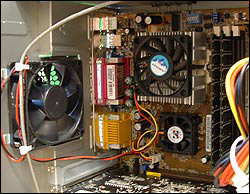Corporations have always been a conservative bunch, slow
to embrace new suppliers in the face of Intel's overwhelming 'warm fuzzy
feeling'. Intel is in a way like a security blanket - the IT department
grew up on it, and they know it backwards and forwards. Any
impetuous to move to a different platform is only going to be brought about
by major performance increases and major cost reductions. Fortunately for AMD,
the Athlon XP2000+ fits into both of these categories with
ease.
As we learned over a cup of coffee with the nice AMD folk at COMDEX last
year, AMD processors are still struggling with the large business segment that
tends to think 'Intel Only'. With 27.5% market share of medium sized businesses
and 39.8% in small businesses, the 6.7% stake that AMD has in large corporations
is just a drop in the bucket. Given the performance numbers we have been seeing
with the Athlon XP 2000+ compared to the Intel Pentium 4 2.0GHz, its not
surprising to see more and more individuals and IT guys siding with the Athlon
for workstation systems. Now naturally there are different levels of
workstations, culminating with a dually for the real die-hards, but even a
single processor system can offer employees a solid computing foundation.
After all, if you're paying someone $80 and hour to do CAD/CAM work (AutoCAD
or Microstation SE for example) you damn well don't want the computer to be the
limiting factor in their productivity. Performance and stability then become the
key points.
With that in mind we are going to be looking again at an Athlon XP 2000+
system to see how well it handles in the workstation environment. Obviously this
is just a starting point from where you could go with the system we're looking
at; upgrading the GeForce3 Ti500 to a Quadro DCC based graphics card, and
increasing the DDR to 3GB for just two examples.
We looked at this same system previously from a gamers perspective, so there
will be some overlap between the two reviews (we're talking about the same
gear), so if you've already read the first review I suggest you jump right a
head to the benchmarks.
Going head to head against the Athlon XP 2000+ will be a Pentium4 2.0GHz
- darling of the corporate world.
Background on the Athlon XP:
The AthlonXP processor incorporates several
new features that it's older brother, the Athlon doesn't have. Most notably is
Quanti-Speed Architecture. What exactly is Quanti-Speed you ask? Well, first off it's really more
of a marketing ploy then anything else, and essentially says that "our
CPU's do more work per clock cycle, so MHz means nothing now." Still, there are some true enhancements
from the Athlon core. Probably the biggest enhancement was the inclusion
of Intel's SSE technology, the same
technology which is inside every Pentium III processor.
Streaming SIMD Extensions were also added to allow
the Athlon XP processors to handle multiple data calculations at
one time. Still, with all this great technology, it's only really useful
if the software programmers code for it. Fortunately for AMD, SSE
has been around for quite some time now, so there are quite a few pieces of
professional software already using it. Not surprisingly AMD chose to call
it 3DNow! Professional rather than SSE.
Next in the line of additions to the Athlon XP is hardware prefetch, which
is built into the "Palomino" core (AthlonXP and AthlonMP). What
hardware prefetch does is look at what the user is doing and try to extrapolate
what piece of data is going to be used next. The processor stores that
prefetched data in the L1 data cache, thereby increasing the speed of
calculations when that data is needed. If it turns out to be wrong, it
will simply flush the cache and get the data that's actually required.
AMD XP model numbers:
Almost each and every company that manufactures
processors has been trying to find ways of educating the consumer about the
dangers of relying entirely upon the "MHz Myth." AMD for itself, has started the
True Performance Initiative (TPI). What the XP model numbers currently in
use are trying to communicate is the relative application performance. The real
goal however is base "performance" ratings on IPC (Instructions executed
Per Clock cycle) x MHz =
TPI. AMD has been
working with many larger OEM's such as Compaq, HP and Sony to
try and create a appropriate performance rating system.
- Athlon XP 2000+ operates at 1.67 GHz
- Athlon XP 1900+ operates at 1.60 GHz
- Athlon XP 1800+ operates at 1.53 GHz
The XP2000+ System:
The XP 2000+ system came to us fully configured in a nice
mid-tower case with space for a rear exhaust fan, and packing up to four HDD bays
(that involves nixing the FDD). The standard OEM power supply
had been replaced with a more powerful 400W Antec to meet the Athlon XP's
higher power requirements.
The standard OEM power supply
had been replaced with a more powerful 400W Antec to meet the Athlon XP's
higher power requirements.
Curiously, a generic FoxConn heatsink was installed on the
Athlon XP 2000+ processor. The heatsink (exact model number unknown) made use of a
chrome plated copper slug screwed on to the base of the aluminum
extrusion in an attempt to boost performance.
With the small fan that the heatsink came equipped with,
average core temperatures hovered around 50-60 degrees Celsius. Noise however,
was not an issue. I would
personally suggest replacing this heatsink with something a bit more powerful, perhaps
an Arkua, Thermal Integration or Alpha 8045.
Athlon processors are known for their high
temperatures, so it was not unexpected to see that the case had also been
outfitted with an 80mm exhaust fan. The Althon XP 2000+ has a maximum listed die temperature of
90 degrees Celsius in case you ever want test it out to the max....

